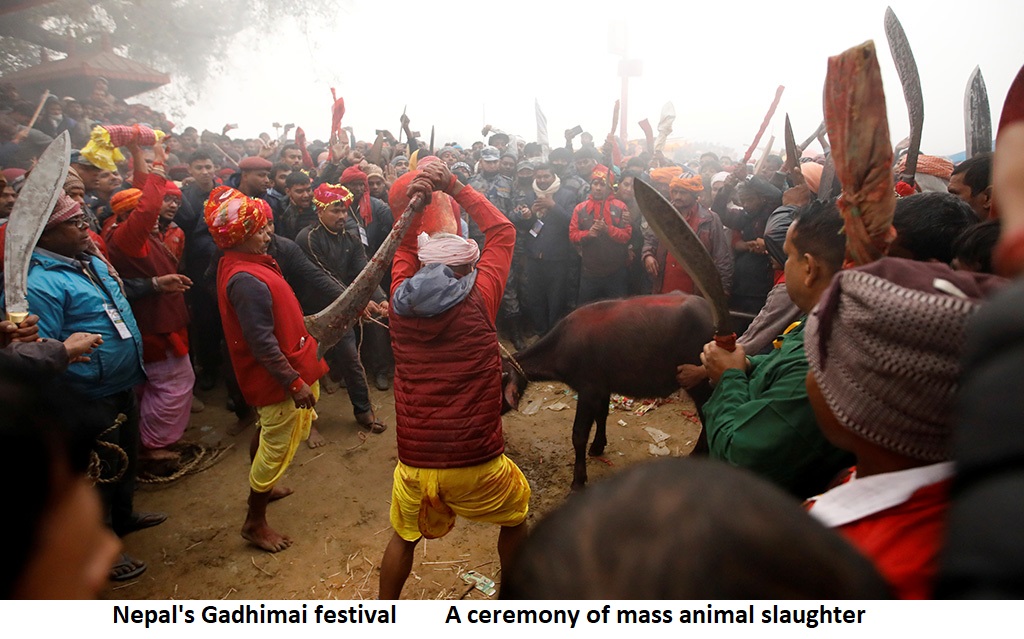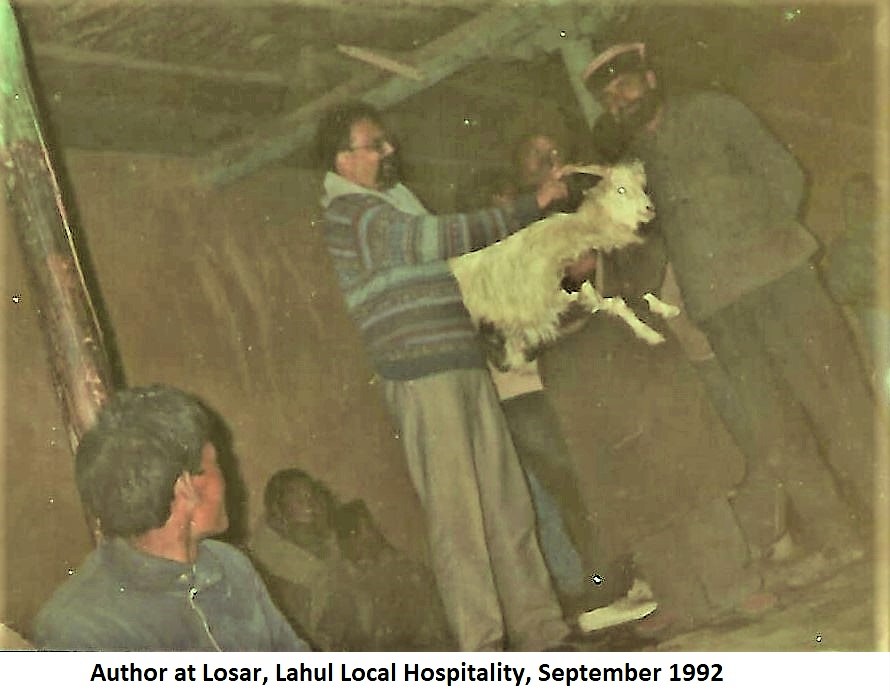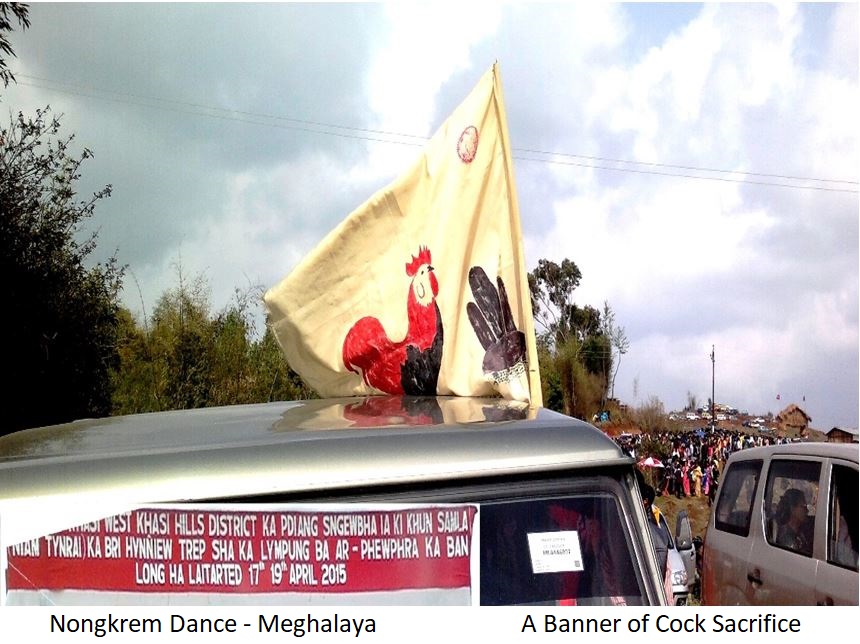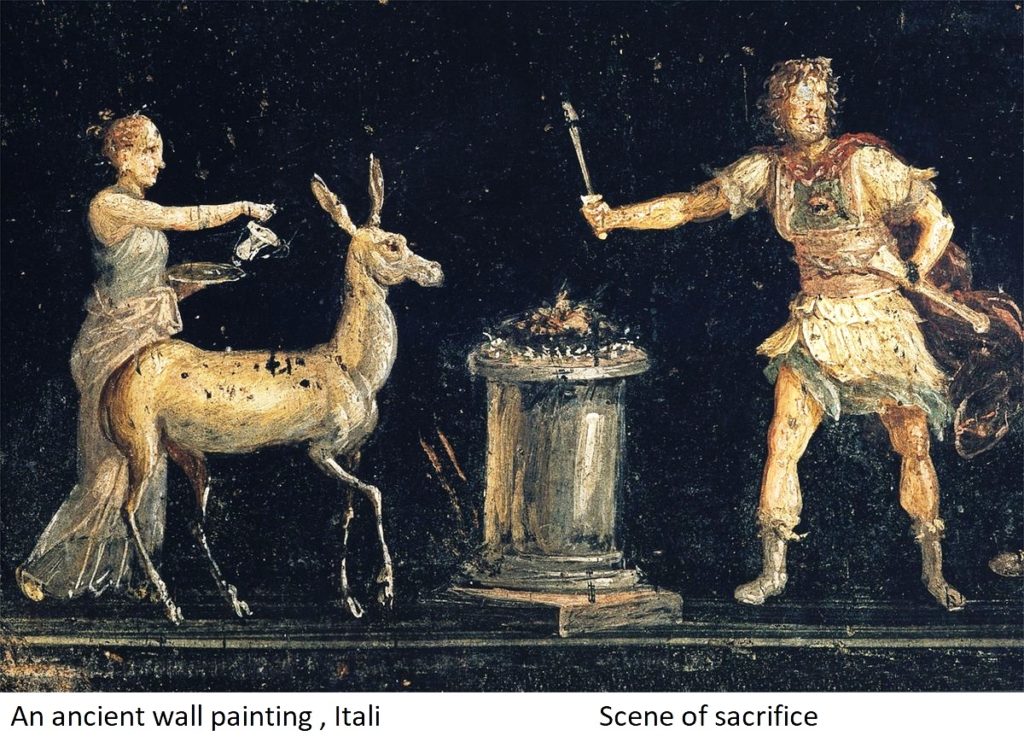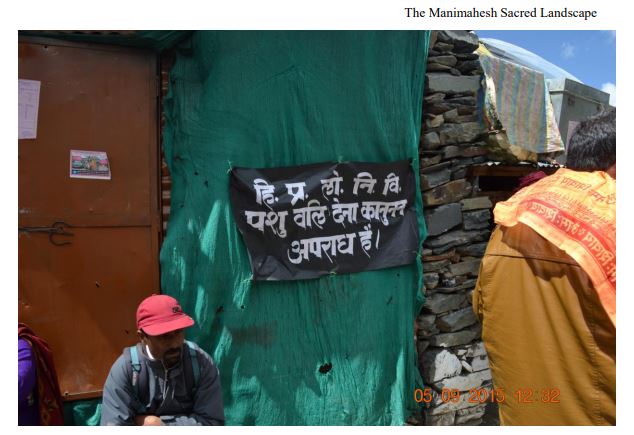‘The Thapa throws from the top of the house a live sheep in front of the wedding party , and its heart and liver are quickly torn out, cut up and eaten raw, the pieces being scrambled for by all the friends present’… ‘Iama brings with him a small pot with dough effigy of the demon inside it. He eventually breaks it and kills the demon in the effigy. Then the party enters the house partakes of the marriage feast.’ *
Greeks, had worked out a justification for keeping the best edible parts of the sacrifice for the assembled humans to eat.
Tens of thousands of devotees carrying swords and large curved knives (khukurs) thronged southern Nepal, December, last year. Thousands of buffalos were beheaded to appease Gadhimai – an avatar of the Hindu goddess of power, Kali – brings them luck and prosperity.
- Animal sacrifice is the ritual killing and offering of an animal usually as part of a religious ritual or to appease a deity. A Sanskrit term used for animal sacrifice is bali , in origin meaning “tribute, offering or oblation”
- Birds are usually the animals used in sacrifice rituals, but it can also be a goat, sheep, chicken, pig, or dog and so on.
- Little guinea pigs, turtles- fish, crabs, doves, ducks, pigeons; &the massive ones were all being sacrificed. The Kalika Purana distinguishes bali (sacrifice), maha bali (great sacrifice), for the ritual killing of goats, elephant, respectively. Horse was sacrificed in Ashwamedha yagya, it was suffocated to death . Ox, bull, male buffalo – water buffalo, cow & camel is no exception either.
- Fowl, chicken, goat- lamb, child pig – pig, sheep; each would be the best specimen of its kind, cleansed, clad in sacrificial regalia and garlanded- the horns of oxen might be gilded. Black rooster has been more common. Rams have been sought after. Even blood, oozing out of cockfights is considered appropriate.
- Ancient India enjoyed religious freedom. Practices of animal sacrifice in Hinduism are mostly associated with Shaktism ^; and strongly rooted in local tribal traditions. Bali also “refers to the blood of an animal” and is sometimes known as Jhatka bali among Hindus.
- In some places such as in Pakistan, qurbani is always used for Islamic animal sacrifice. The sacrificial animal may be a sheep, a goat, a camel, or a cow. The animal must be healthy and conscious.
- Santeria and the lineages believe it to be a means of curing the sick and giving thanks to the Orisha (gods). Animals are cooked and eaten following all Santeria rituals (except healing and death rites, where the sickness is believed to pass into the dead animal). Eating the sacrificed animal is considered a sharing with the Orisha , who only consumes the animal’s blood, while the worshippers eat the meat.
- At Mindhal Devi temple of Pangi (Chamba), herds of sheep and goat are sacrificed keeping in with sukhna (saying of wish) of people to the deity. It is believed that blood of the sacrificed livestock flows through a hole at the temple door to a pool at the foot of Kulal village.
- In Indonesian island of Bali, the religious belief of Tabuh Rah, a form of animal sacrifice, includes a cockfight. The spilling of blood is necessary as purification to appease the evil spirits. In the Indian state of Kerala cockfight is a religious exercise of offering blood to the Theyyam gods.
- Christians from some villages in Greece also sacrifice animals to Orthodox saints in a practice known as kourbania.
- Israelites believed that sacrifice was a necessary part of the relationship between God and man. Animal sacrifices were common throughout Europe and continue in some cultures and religions today.
- The Raj puts of Rajasthan worship their weapons and horses on Navratri, and formerly offered a sacrifice of a goat to a goddess revered as Kuldevi – a practice that continues in some places. The ritual requires slaying of the animal with a single stroke.
- Animal sacrifice is a part of some Durga puja celebrations during the Navratri in eastern states of India.
- In Karnataka, the goddess receiving the sacrifice is believed to be Renuka. The animal is either a male buffalo or a goat. In region around Pune Goats and fowls are sacrificed to the God Vetala.
- In Orissa Ghusuri (a child pig), is sacrificed to the goddess every three years.
- In region around Pune, goats and fowls are sacrificed to the god Vetala.
- The goddess temples in Assam, Tripura and West Bengal in India and Nepal where this takes place involves slaying of goats, chickens, pigeons and male Water buffalos.
- In Meghalaya, at Nongkrem Dance festival, the High priest offers oblation to the god of Shyllong peak by sacrificing a cock. An important part of this festival is Pemblang (sacrifice of goats). Colorful banners of Cock Sacrifice is a common sight.
- ‘In Kinnaur, Himachal, brothers marry a joint wife, the Lamas solemonising the wedding by chanting certain hymns, worshipping the gods or godesses and sacrificing goats.’*
- The animals are killed by cutting the carotid arteries with a single knife stroke in a similar way to other religious methods of slaughter range from decapitation, strangulation, to a spike being driven into the heart of the animal. Jhatka is the prescribed method for Hindu ritual slaughter; this method requires the instant killing of the animal in a single decapitating blow with an axe or sword. Ironically, Priests see ‘an animal making noise as a bad omen’ that smacks of its suffering.
- Among Greeks blood sacrifices were divided into burnt offerings in which the whole unmaimed animal was burnt (holocaust), guilt offerings (in which part was burnt and part left for the priest) and peace offerings (in which only part of the undamaged animal was burnt and the rest eaten in ritually pure conditions).
- Sacrifices are performed for life events such as birth, marriage, and death. They are also used for healing. As if, without sacrifice the religion would die out, and, therefore, sacrifice is essential for initiation into the faith in community and the satisfaction of priests.
- According to Walter Burkert, a scholar of sacrifice, Greek sacrifices derived from hunting practices. Hunters, feeling guilty for having killed another living being so they could eat and survive, tried to repudiate their responsibility in these rituals. According to one school of thought, the animal is sacrificed as food, rather than for any obscure mystical purpose.
- Sacrifices could include bloodless offerings (grain and wine), the animal sacrifices were considered the most important by many.
- In the past, animal sacrifice was practiced at ancient Shakti temple, Bahu Fort(3000 years old ) , in the city of Jammu which has since been discontinued. Today, a priest performs a few rites uttering some religious incantations and sprinkles holy water over the animal (usually a sheep or goat) and then lets it go free.
- The tradition of animal sacrifice is being substituted with vegetarian offerings to the Goddess in temples and households around Banaras in Northern India. The majority of modern Hindus avoid animal sacrifice.
- Recently, for symbolic sacrifices, coconuts had substituted animals (a buffalo, a male sheep, a fish, a crab and a chicken) as offering to appease gods and goddesses at the culmination of the week-long- festivities of International Kullu Dussehra festivities.
- In the Mahakali Kund of Manimahesh Dal Lake, coconut sacrifice is now offered in place of the ram. Travelers coming from Jammu and Kashmir are also prevented from leaving with cattle.
- Hindu scriptures, including the Gita and the Puranas forbid animal sacrifice. The practice, while publicly condemned, is often tolerated.
- In 2014, Himachal High Court had observed, “A startling revelation has been made as thousands of animals are sacrificed every year in the name of worship. Sacrifice causes immense pain and suffering to innocent animals. They cannot be permitted to be sacrificed to appease a god or deity in a barbaric manner.”
However, the practice of animal sacrifice has lingered on in certain local contexts.
……………………………………………………………………………………………………………………………………………………
* POLYANDRY IN THE HIMALAYAS Y S PARMAR
^Shaktism “doctrine of energy, power, the eternal goddess” is a major sect of Hinduism, wherein a woman and Shakti is regarded as the supreme godhead.
Nepal’s Gadhimai Festival PHOTO REUTERS Losar Lahul, Cock sacrifice PHOTOS Author’s collection
Prof. (Er.) Chander P Mahajan is an art critic & a free lance journalist. The Environmentalist stays in Shimla and Dalhousie, Himachal Pradesh, India.


